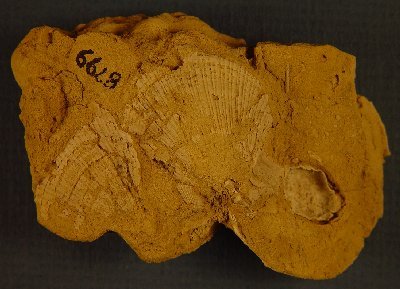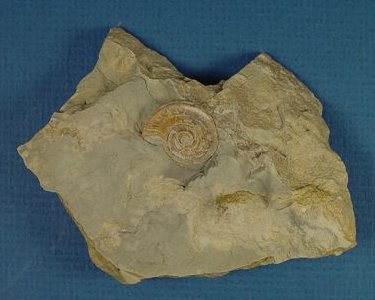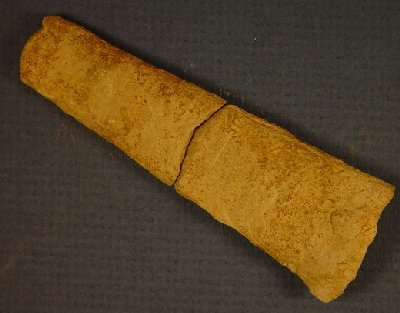Bivalves
Bivalvia (=Pelecypoda) is a class of mollusks that includes clams, oysters, mussels, scallops and the extinct rudists. Bivalves have also been called pelecypods (hatchet foot) because their soft bodies resembled the head of a hatchet. The name bivalvia, however, appeared in print earlier than pelecypoda and has become the more accepted term in paleontology (see reference 1)
Pectenoid Bivalves
Aviculopecten sumnerensis
"Aviculopecten sumnerensis" (Newell) is a pectenoid bivalve that is somewhat scarce in the Grant Shale. Pectenoid bivalves are similar in appearance to modern scallops. Pectenoid bivalves are sometimes "free swimmers" to the extent that they can move along the substrate or in a watercolumn by rapidly shutting their valves. The "swimming" they do is usually not directed toward a goal but it may provide the bivalve with a mode of escape from a predator.

Gastropods
Gastropoda (stomach foot) is a class of bivalved mollusk that have found habitats in fresh, brackish, saline, or hypersaline water, and on land. The few brachiopods so far collected from the Grant Shale are all marine snails.
Low Spired Snails
Straparollus (Euomphalus)
"Straparollus (Euomphalus)" sp. is a fairly common and long-ranging species to be found in both limestone and shale deposits of Pennsylvanian and Permian age in the midcontinent. The relationships of "Straparollus (Euomphalus)" to other organisms found in the Grant Shale is currently not known. Many of the snails that lived in the late Paleozoic appear to have had rather soluble shells and are often preserved only as casts or steinkerns. "Straparollus (Euomphalus)" is an exception.

Cephalopoda
Cephalopoda (head-foot) is a class of free-swimming mollusks that in modern seas includes squid, octopus, and the chambered nautilus. They are strong swimmers and most are predators, feeding on other invertebrates and fish. Most have a ring of tentacles that surrounds the mouth and a chitinous radula for "beak" that is used to shred food (see references 2a - 2d).
Low Spired Snails
Dolorthoceras sp. cf. D. ciscoense Miller
"Dolorthoceras sp. cf. D. ciscoense Miller" Miller, Dunbar & Condra was a (nektonic) free-swimming nautiloid cephalopod. "D. ciscoense" was described by Miller, Dunbar and Condra (1933, p. 96, 97) on the basis of material that was collected from rocks of the Cisco Group (late Pennsylvanian to early Permian) near Brownwood, Texas. The living nautiloid is characterized by having a shell made up of chambers that are connected by way of a hose-like structure called a siphuncle. The nautiloid can adjust the volume of gas to water inside its chambered shell to control the depth at which it swims in the water column. The body of the nautiloid occupied a large body chamber at the anterior of the animal and the remainder of the shell behind the body chamber is called a phragmocone. In the living organism, there is a ring of tentacles that surround the mouth and there is a chitinous radula or "beak" that the animal uses to tear apart its prey. Nautiloids were probably predators in the late Pennsylvanian and early Permian seas that covered Nebraska and the midcontinent.
